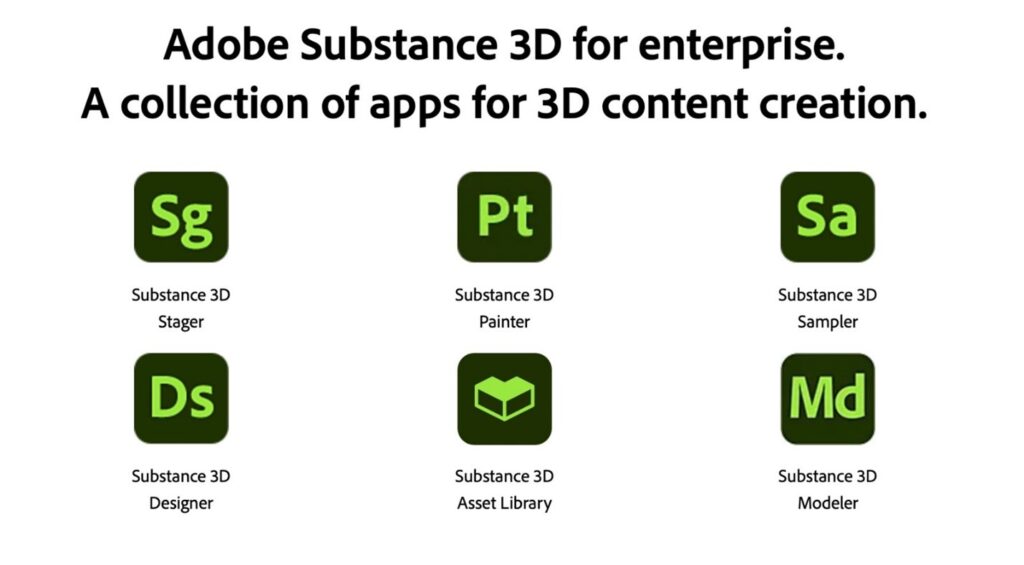Adobe Substance adds new options for 3D content creation.

In 2022, Adobe came through on its promise to advance its portfolio of 3D content creation tools packaged as Adobe Substance 3D and now available for subscription. Also, at Max 2022, Adobe left clues, pointers, and demos to new capabilities including full-3D capture capabilities for mobile devices.
The message at Max was clear: Adobe intends to join the ranks of the leading 3D content creation tool makers, and the tools introduced at this year’s show clearly solidifies their position in the 3D content creation ecosystem in a way that’s also compatible with Adobe’s established tool sets.
The complete list of tools looks like this:
Substance 3D Painter—Tools to paint and texture assets. Paint strokes can be modified through layer manipulation in a WYSIWIG interface.
Substance 3D Stager—Allows the creation of 3D scenes by combining 3D assets such as models, materials, lights, and cameras. Users can drag and drop 3D assets, materials, lights, and cameras to set up a shot, and export photorealistic rendered images, publish to the Web, or share in AR.
Substance 3D Sampler—Enables materials to be created and edited from photos.
Substance 3D Designer—For node-based 3D dimensional material creation, it provides tool lighting, parametric materials, image filters, environment lights that can be manipulated to create and edit new assets including 3D models. Materials can be used in Stager but also in a broad range of 3D DCC applications across the game, VFX, and design industries.
Substance 3D Modeler—3D sculptural modeler.
Substance 3D Assets—Adobe says they have over 15,000 customizable models, lights, and materials available for all industries.
Adobe Aero—Enables mobile augmented reality experiences to be created on MacOS or Windows desktops, and in iOS as a public beta.
For many attendees, the Max 2022 headliner was the Substance 3D Modeler, which includes support for VR headsets from Meta so that people can work dynamically between immersive and desktop interfaces. The Substance Modeler was built on Adobe Medium, which the company acquired from Oculus in 2021. It works like Pixologic’s ZBrush, Autodesk’s Mudbox, or Pixologic’s ZBrush, with sculptural tools that let users push, pull, gouge, and shape models using digital clay.
Modeler will work within the Substance ecosystem of tools, which was established around textures and materials, with procedural tools that can be used to edit and create 3D materials. So, once users get a shape they like, they can use Substance Materials to further define the model. The drawback to sculptural modelers is that the resulting meshes are heavy and may require quite a bit of post-processing for use in game engines, other 3D modelers, CAD, and so forth. Adobe talked about the Substance Modeler as a tool for prototyping, character development, and exploring design ideas.
It’s important to note that Substance Modeler uses a layer-based approach that is consistent with Adobe’s major tool families: Photoshop, Illustrator, and Premiere.
At Max, the Substance Modeler was shown with Substance Stager, a tool introduced earlier by the Substance team that enables creators to combine 3D models into a scene. Currently, content can be exported from Stager as an SBSM, which preserves editability, or the scene can be exported as an FBX, OBJ, or PLY file, which is editable in other 3D creation tools.
The Substance 3D Sampler has been a tool for capturing materials. For this year’s Max, demos suggested a new version of Sampler will enable model creation through photogrammetry. Another demo from Sneaks called Project Scantastic showed models being created using the mobile phone camera to capture simple objects with photo-based textures. The photogrammetry apps were not completely fleshed out or defined as actual products or parts of products, but you can certainly see how the Substance team is thinking. It’s an exciting proposition.

To get an idea about using the Substance tools, see Adobe’s tutorials that have been developed for the emerging platform.
To the metaverse and beyond
On a broader level, Adobe has declared itself a card-carrying member of the metaverse ecosystem, no matter how it’s defined. This comes on the heels of Tim Cook’s assertion that he doesn’t think the metaverse is anything for Apple to worry about because people don’t understand what it is.
Granted, no one should ever place much stock in what any CEO says publicly about their response to a budding trend or their plans for future products. For all we know, Cook and company have already built a metaversical theme park with rides and popcorn, and they’re just waiting for the right time to open the box office. But Adobe is different in that it’s inviting the creative community in and handing them the keys to the DeLorean so that the community can get to work and build.
Tellingly, Sebastien Deguy, who brought Substance into Adobe, is now vice president and head of 3D and metaverse there. He says, “At Adobe, our mission is to support creatives and brands as they transition into new mediums, including immersive experiences….” He has displayed an appreciation for Adobe’s traditional creators as well as his tribe of 3D natives. In a recent talk, Deguy discussed how adjacent art forms can inform 3D creation. When talking about the new technology in 3D Capture, he said, “If you know photography, you know 3D. The better the quality of the picture, the better 3D image you will be able to create.”
Getting the whole picture
Max is Adobe’s marketing showcase for the Creative Cloud. As such, it can be difficult to figure out what’s actually shipping and what is to come. That seemed especially true with the Substance announcements. The other common criticism is that Adobe’s brilliantly crafted demos tend to gloss over the real challenges typical users might stumble over.
The Substance team is developing tools for immersive content creation as well as integrated AR apps for the phone, along with assets for 3D creation in non-Adobe applications including the Unreal and Unity game engines, Autodesk Maya, Maxon Cinema 4D, and Blender, to name a few. In this, the company is being determinedly practical. They’re offering building blocks, not a vision.
Meanwhile, the company is also engineering a big shift within its walls. The acquisition of Substance has opened the gates to a cultural change within the company, which will probably become clearer as the Substance team assimilates but also pioneers new opportunities, thanks to its alliances in game development, CAD, and the territory that lies between.
The new Substance tools are cross-platform and take advantage of Apple’s new processors, the M1 and M2. Early testers have commented on the smooth interaction they notice while working on the new Macs.
The Substance 3D Collection of tools is officially priced at $49.99 per month but will be available for users’ first year at half price $24.99.






